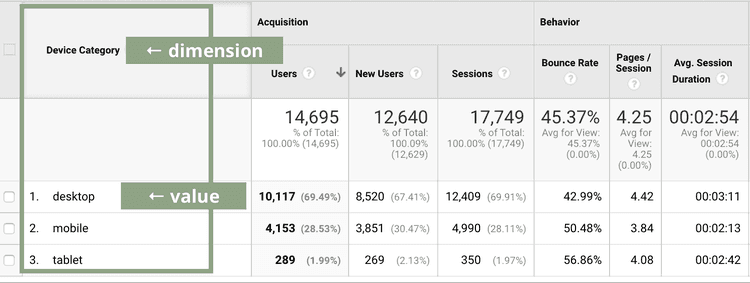The Significance of 'Secondary Dimensions' in Google Analytics: In-depth Analysis
Wiki Article
Decoding the Relevance of Additional Measurement in Google Analytics: Everything About Its Importance and Influence
In the realm of electronic analytics, the application of secondary dimensions within Google Analytics acts as a pivotal tool for critical much deeper layers of data insights. The value of additional measurements lies in their capability to give a nuanced view of individual behavior and communication with an internet site or platform. By exploring information past surface-level metrics, companies can unlock a wide range of information that shapes calculated decisions and refines advertising and marketing efforts. This exploration into the world of secondary dimensions not just provides a comprehensive understanding of customer engagement but likewise loses light on the intricate dynamics that drive on the internet efficiency.Comprehending Second Dimensions in Google Analytics
The understanding of secondary measurements in Google Analytics is essential for obtaining much deeper insights right into individual actions and web site efficiency. While main measurements offer fundamental data points such as website traffic resources and web page sights, secondary measurements permit a much more nuanced analysis by providing additional context to these primary metrics. By including secondary measurements, individuals can sector and filter their information to uncover patterns and trends that may not be instantly obvious.Introducing the Conveniences of Additional Dimensions
Structure upon the foundational understanding of secondary dimensions in Google Analytics, exploring the advantages they offer discloses indispensable insights for improving information analysis and decision-making. By including secondary measurements, individuals can dive deeper into their data, gaining an extra thorough view of individual actions, content efficiency, and various other vital metrics.Moreover, secondary measurements supply context to key information, offering added layers of details that can assist in comprehending customer communications and choices. This improved understanding can guide tactical decision-making, bring about more targeted advertising and marketing campaigns, internet site optimizations, and general enhanced performance. In essence, second measurements function as a powerful device for opening much deeper insights and optimizing the utility of Google Analytics for organizations and site owners.
Leveraging Secondary Measurements for Boosted Insights
By harnessing the power of second dimensions in Google Analytics, organizations can uncover deeper understandings that drive educated critical and decision-making optimization efforts. Leveraging additional dimensions permits companies to delve beyond surface-level data and get an extra detailed understanding of user actions, target market demographics, traffic sources, and web site efficiency. By integrating key measurements like traffic resources with additional dimensions such as geographical place or device classification, organizations can determine which gadgets or areas are driving the most useful web traffic to their website.Moreover, secondary dimensions make it possible for organizations to sector and assess information extra properly, assisting them identify fads, patterns, and opportunities that might have or else gone undetected. By using second measurements, companies can customize their marketing approaches, web content, and user experience to much better satisfy the requirements and choices of their target market. In essence, leveraging additional measurements in Google Analytics empowers services to make data-driven choices that cause enhanced efficiency, raised ROI, and sustainable growth.

Influence of Second Measurements on Data Evaluation
Enhancing information evaluation with the use of second measurements in Google Analytics gives companies with a deeper understanding of their online you could try here performance metrics. By integrating second dimensions, such as time of day, geographic area, or tool classification, businesses can discover useful understandings that might have been ignored with key dimensions alone. This enhanced degree of granularity enables even more specific division of information, making it possible for services to recognize patterns, fads, and relationships that can drive strategic decision-making.
Optimizing Potential: Second Dimensions Techniques
The tactical utilization of additional dimensions in Google Analytics extends beyond boosting information evaluation; it includes crafting targeted techniques to unlock the complete capacity of valuable understandings for organization growth. By employing second dimensions effectively, companies can dive much deeper into their web site web traffic, customer actions, and marketing campaigns to draw out workable insights. One essential approach is to integrate second dimensions with main dimensions to obtain an extensive view of individual interactions. As an example, coupling the main measurement of 'source/medium' with secondary measurements like 'touchdown web page' or 'gadget classification' can reveal which networks are driving website traffic see this here to particular pages or exactly how customer actions differs across devices.Moreover, making use of secondary measurements to sector data based upon individual demographics, habits, or modern technology can assist organizations tailor their advertising efforts to specific target market segments. This targeted strategy can cause enhanced conversion rates, boosted individual experiences, and ultimately, increased ROI. By taking full advantage of the possibility of secondary dimensions in Google Analytics, businesses can make informed choices, enhance their on the internet visibility, and drive lasting growth.
Final Thought
In final thought, secondary dimensions in Google Analytics play an important duty in supplying much deeper insights and improving data analysis. Incorporating second dimensions into information analysis strategies can lead to even more informed decision-making and improved general performance.While primary measurements give fundamental information points such as website traffic sources and web page sights, additional dimensions enable for an extra nuanced evaluation by supplying extra context to these primary metrics. By combining key measurements like web more tips here traffic sources with additional dimensions such as geographical place or device category, companies can recognize which areas or devices are driving the most useful web traffic to their website.
By integrating second dimensions, such as time of day, geographic area, or device group, companies can reveal important insights that may have been overlooked with primary measurements alone. One key method is to incorporate second measurements with key measurements to gain a detailed sight of individual interactions. Matching the main dimension of 'source/medium' with secondary measurements like 'touchdown web page' or 'device classification' can reveal which networks are driving web traffic to specific web pages or just how individual habits differs throughout tools.
Report this wiki page